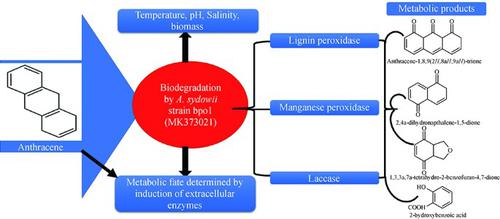Frontiers of Environmental Science & Engineering ( IF 6.4 ) Pub Date : 2020-11-05 , DOI: 10.1007/s11783-020-1292-3 Paul Olusegun Bankole , Kirk Taylor Semple , Byong-Hun Jeon , Sanjay Prabhu Govindwar

|
The present study investigated the efficiency of Aspergillus sydowii strain bpo1 (GenBank Accession Number: MK373021) in the removal of anthracene (100 mg/L). Optimal degradation efficiency (98.7%) was observed at neutral pH, temperature (30°C), biomass weight (2 g) and salinity (0.2% w/v) within 72 h. The enzyme analyses revealed 131%, 107%, and 89% induction in laccase, lignin peroxidase, and manganese peroxidase respectively during anthracene degradation. Furthermore, the degradation efficiency (99.8%) and enzyme induction were significantly enhanced with the addition of 100 mg/L of citric acid and glucose to the culture. At varying anthracene concentrations (100–500 mg/L), the degradation rate constants (k1) peaked with increasing concentration of anthracene while the half-life (t1/2) decreases with increase in anthracene concentration. Goodness of fit (R2 = 0.976 and 0.982) was observed when the experimental data were subjected to Langmuir and Temkin models respectively which affirmed the monolayer and heterogeneous nature exhibited by A. sydwoii cells during degradation. Four distinct metabolites; anthracene-1,8,9 (2H,8aH,9aH)-trione, 2,4a-dihydronaphthalene-1,5-dione, 1,3,3a,7a-tetrahydro-2-benzofuran-4,7-dione and 2-hydroxybenzoic acid was obtained through Gas Chromatography-Mass spectrometry (GC-MS). A. sydowii exhibited promising potentials in the removal of PAHs.
中文翻译:

红树林土壤真菌曲霉BPOI对蒽的酶促去除作用
本研究调查了米曲霉菌株bpo1(GenBank登录号:MK373021)去除蒽(100 mg / L)的效率。在72小时内,在中性pH,温度(30°C),生物质重量(2 g)和盐度(0.2%w / v)下观察到最佳降解效率(98.7%)。酶分析表明,蒽降解期间漆酶,木质素过氧化物酶和锰过氧化物酶分别产生131%,107%和89%的诱导。此外,通过向培养物中添加100 mg / L柠檬酸和葡萄糖,降解效率(99.8%)和酶诱导显着增强。在不同浓度的蒽(100-500 mg / L)下,降解速率常数(k 1)随着蒽浓度的增加而达到峰值,而半衰期(t 1/2)随着蒽浓度的增加而降低。当分别对实验数据进行Langmuir和Temkin模型进行实验时,观察到拟合度(R 2 = 0.976和0.982),这证实了拟南芥细胞在降解过程中表现出的单层和异质性。四种不同的代谢物;蒽-1,8,9(2 H,8a H,9a H)-三酮,2,4a-二氢萘-1,5-二酮,1,3,3a,7a-四氢-2-苯并呋喃-4,7-通过气相色谱-质谱法(GC-MS)获得二酮和2-羟基苯甲酸。拟南芥 在去除多环芳烃方面显示出广阔的前景。


























 京公网安备 11010802027423号
京公网安备 11010802027423号